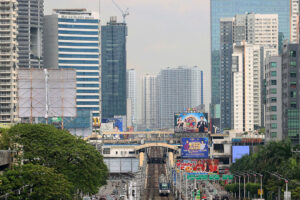
NATIONAL Economic and Development Authority Secretary Arsenio M. Balisacan is hopeful the economy grew by at least 6% in the first quarter, as rate cuts and cooling inflation drove up domestic consumption.
Mr. Balisacan told reporters it may be unrealistic to expect gross domestic product (GDP) growth to hit the upper end of the 6-8% target amid global uncertainty over the US tariff policy.
However, it may be too early to revise the growth targets, he added.
“Yeah, we are keeping for now the 6%, 6-8% growth. And we’re still quite confident that we may hit at least the low-end part (of the full-year target),” he said.
Asked if first-quarter GDP may have expanded faster than the 5.9% print in the first quarter of 2024, Mr. Balisacan replied: “If we are going to get something close to that (5.9%) for the first quarter, that to me is a respectable achievement. But I would like to see hopefully 6%.”
First-quarter GDP data will be released on May 8.
“Our target is to move the economy faster than it used to so that we can catch up with our neighbors,” Mr. Balisacan said.
Mr. Balisacan said domestic consumption, which makes up around three-quarters of GDP, will continue to drive growth.
“I would think that because of the lower interest rates and the much more favorable inflation that has happened over the last first three months of the year, this would surely have impacted favorably on domestic consumption,” he said.
In the first quarter, inflation averaged 2.2%, well within the central bank’s 2-4% target range.
The Bangko Sentral ng Pilipinas paused its easing cycle in February, but cut rates by 25 basis points at its meeting last week. This brought the target reverse repurchase rate to 5.5% from 5.75% previously.
Mr. Balisacan said second quarter economic performance may be “challenging” amid the turmoil caused by the US reciprocal tariffs.
US President Donald J. Trump on April 9 paused the new reciprocal tariffs for 90 days, although the baseline 10% tariff on almost all US imports remained in effect.
The Philippines faced a 17% reciprocal tariff, although this was the second lowest among Southeast Asian countries.
“In fact, when we did our simulation, the net benefits for us in terms of the increases in exports, overall exports, not just for the US but overall, as well as for increases in GDP, are now more favorable for us compared to the reciprocal tariffs,” he said.
Mr. Balisacan said that exports could possibly increase by 1.5% with the 10% blanket tariff during the 90-day pause.
“But then again, because exports as a contributor to our economy is quite small, the overall impact and impact is still quite high,” added.
The Development Budget Coordination Committee projects 6% and 5% growth in exports and imports, respectively, this year.
Despite the growing uncertainty in global trade, Mr. Balisacan said the Philippine economy remains relatively insulated due to its smaller role in global trade compared to its Asian neighbors.
“The economy is not as vulnerable to shocks in the global marketplace as our neighbors… because the Philippine economy’s exposure to trade is fairly small,” he said.
However, he cautioned against complacency, stressing the importance of strengthening export performance by diversifying markets and addressing investment constraints so the country could take advantage of trade diversion opportunities resulting from the sweeping US tariffs.
“We need to double, even triple, our efforts to improve the investment environment so investors see the Philippines as a viable destination,” Mr. Balisacan said. — Aubrey Rose A. Inosante with Reuters




